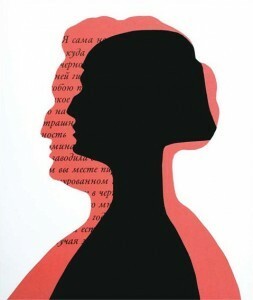At Aktis Gallery
Caroline Maclean
You crazy people! I myself don’t know,
I just don’t know which way this is –
In straying to the black abyss,
To death itself, or paradise,
I’ll take you with me as I go.
Anna Akhmatova, Moscow, 10 October 1959 (afternoon).
The Soviet filmmaker Aleksandr Askoldov once joked that ‘things shouldn’t be too good for artists.’ After making Commissar in 1967, Askoldov lost his job, was expelled from the Communist party, banned from filmmaking, exiled from Moscow and told that the one copy of his film had been destroyed. (It was eventually released in 1988.) At Aktis Gallery last week, a previously unpublished poem by Anna Akhmatova (part of it above), illustrated by Vladimir Yankilevsky and published by Anatoly Naiman, was launched in a limited edition of 130 copies. The first line has been translated as ‘You crazy people!’ but it might also be interpreted as ‘We crazy people!’ – a more inclusive madness. John Morrison, who reported from the Soviet Union for Reuters, read from a copy of Akhmatova’s poems published for Westerners in the 1960s. It described how her ‘path’ had not been ‘straight’ – a euphemism for the execution of her former husband Nikolai Gumilev in 1921, the internment of her son in a Siberian labour camp and the official ban on her work in 1925.
Yankilevsky’s path hasn’t been straight either. Unable to exhibit after Khrushchev cracked down on the avant-garde in 1962, he worked as a book designer. Walking round the gallery, which is showing over 40 of Yankilevsky’s early works, is like eavesdropping on the young artist in private conversation with Henry Moore, Kandinsky, Klee, Picasso, Miró, even perhaps Morandi, before coming to one of his extraordinary early triptychs: Triptych No. 4: A Being in the Universe (Dedicated to Dmitri Shostakovich) (1964). For years his only access to Western art was in black and white pictures in books from the Moscow Library of Foreign Literature. Yankilevsky has created a triptych for Akhmatova’s poem showing her famous profile as a young and older woman (she joked about how often it was reproduced) in a strong red and black design.
Yankilevsky described his early experimentation with form in a conversation with David Riff. Instructed to draw from life models from an early age, he found he could do it effortlessly and so started to express the feelings from inside the model. He made elbows sharper or hands thicker to convey the weight leaning on them. ‘I drew the leg which was tense and ignored the relaxed leg. It didn’t exist, sort of.’
